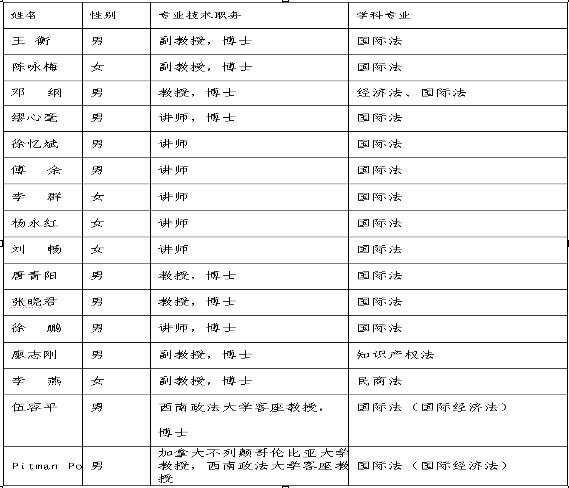Course Brief
一、课程目标及性质(Course Objective and Nature)
国际贸易法成案分析(货物贸易支付法成案节选)旨在培养学生掌握将货物贸易支付法应用于实践的能力,培养国际视野与竞争力。
Cases study on international trade law (section: law of payment for trade in goods) is aimed to develop the capacity of students to apply the law of payment for trade in goods to the practice. It helps to develop the international horizon and competitiveness of the students.
本课程为选修课。
The nature of this course is selective courses of law.
二、课程预期效果(Expected Outcome of this Course)
通过学习此课程,学生将熟悉国际贸易法(尤其是国际货物贸易支付法)规则与案例,具备将规则运用于国际实务,并解决国际贸易争端的基本能力。这些效果具体包括:
After completion of this course, the students are expected to be familiar with cases and practices of international trade law (particularly law of payment for trade in goods). They are also familiar with the application of the rules into practice and have the basic capacity of solving the international trade disputes. These effects include:
1. 使学生对国际贸易法的法律框架及思维方式有感性认识
1. To enable the students to have perceptual knowledge about the construction of and the method of reasoning of international trade law.
2. 使学生大致熟悉国际贸易法案例制度;
2. To help the students to have preliminary knowledge of trade law cases.
3. 使学生基本掌握查找、消化、分析与运用国际贸易判例的方法;
3. To help the students to obtain the basic technique of searching, digesting, analyzing and utilizing trade law cases or precedents.
4. 在今后法学理论研究方面,使学生有能力驾驭英文案例;
4. To help the students to be capable of handling legal cases and precedents in the future study of the theory of Law.
5.在今后实践中,指引学生学会如何应用国际贸易法规则;
5. To guide students on how to apply international trade rules to the practices.
6. 拓展学生的国际视野,提高法律与专业外语等方面的综合竞争力,明确职业发展方向。
6.To broaden the international horizon of the students, to enhance their competitiveness in terms of legal knowledge and legal English, and to guide them in terms of their future career development..
三、授课目标和学时学分(Teaching Target and Credits)
本课程针对法学和相关专业各年级本科学生。
This course is open for undergraduate students specialized in law and related subjects.
本课程30学时,计2学分。
It is of 30 classes and 2 credits.
四、与其他课程的关系(Linkage between this Course and the Others)
建议选修本课程学生此前已完成国际经济法、民商法、国际私法、国际公法的学习。本课程主要涉及国际经济法、民商法(合同法)、国际私法(民商事法律适用)、国际公法(国际经济组织)等领域。
To highly recommend students selecting this course to have completed their courses on international economic law, civil and commercial law, private international law, and public international law. The main part of this class involves studying in the field of international economic law, civil and commercial law (contract law), private international law (applicable law in civil and commercial affairs), and public international law (international intergovernmental organizations).
五、授课方式(Teaching Methods)
因本课程内容丰富,但课时数非常有限仅为30学时,为避免讲授在较短时间里流于肤浅介绍,在每年度开课前,给学生提供授课模块菜单,学生根据菜单提出授课内容建议,针对大部分学生的意见确定和细化课程主要内容。
The substance of this course is very broad and informative, but the course schedule is compressed into 30 hours only. Therefore, prior to the school term every year, we offer our students with the model and selection for our school curriculum, and based on which the students make their choice and give us their suggestion. We will then pinpoint and extract the principal substance from the course according to their feedback. Our lectures will be focused on some particular subject to meet the real needs.
课程主要授课方式:
1.课堂讲授(lectures)
2.案例分析(case studies)
课程其他授课方式:
3.讨论课(seminars)
4.学生陈述(presentation)
5.模拟法庭(moot court)
通过多种灵活多样的方式,提高教学质量,最大程度调动学生兴趣,以及积极性和主动性。
课程讲授全程使用幻灯片,投影仪、教学电脑、话筒、白板等教学工具。
The course would also be supported by the presentation slides in the form of PowerPoint, projectors, computers, microphones, and whiteboard.
六、师资力量(Teaching Staff)
授课教师主要来自于365备用线路检测国际法学院教师,不乏一些我校最早几批获得双语教学资格的教师。大多数教师具有丰富双语教学经验,大多具有美国、英国、加拿大、日本、德国、澳大利亚、瑞士、荷兰等国海外留学和工作经历,能承担授课模块菜单所有课程的中英文讲授任务。此外,还有部分外聘教师及外籍教师。
The course would be taught by the faculty members from International Law School, Southwest University of Political Science and Law, including those who are one of the first groups of certified SWUPL bilingual teachers. The vast majority of them have rich experience in bilingual teaching, and/or teaching/study experience abroad in the USA, United Kingdom, Canada, Japan, Germany, Australia, Switzerland, or Netherlands. It makes them more capable of teaching all the classes using Chinese and English language in this program. Moreover, there are some foreign teachers from the leading university schools to joint us in this program.

七、教材及参考资料(Textbooks and Reference Materials)
推荐教材
1. Ray August, International Business Law(《国际商法》), 高等教育出版社2002年版。
2. 莫世健,International Commercial Law(《国际商法》), 中国法制出版社/LexisNexis(律商联讯出版社), 2004年版。
参考资料:
1.Jerold A Friedland, Understanding International Business and Financial Transactions (《理解国际商事与金融交易》), LexisNexis , 2002.
2.Genaro C. da Costa, International Trade and Payments (《国际贸易与支付》), Himalaya Publishing House, 2004.
3.Jan H.Dalhuisen et al., Dalhuisen on International Commerical, Financial and Trade Law (《Dalhuisen论国际商事、金融与贸易法》), Oxford and Portland, Oregon, US: Hart Publishing, 2000.
4.William A. Lovett, Banking and Financial Institutions Law,(银行与金融机构法) Fourth Edition, West Nutshell Series, 法律出版社与 West Group, 2001.
5.Scott, Hal S. and Philip A. Wellons, International Finance: Transactions, Policy, and Regulation(《国际金融:交易、政策与监管》), Eighth Edition, Foundation Press, 2001.
6.毛浚纯, 王永, 黄基迅, 毛汨静编著,《案例分析和法规选读》,浙江大学出版社。
八、教学内容(Course Contents)
Class 1--Chapter 1.1: Introduction to Tool of International Payment and Settlement
Class 2--Chapter 1.2: Case Study on Non—causation Principle of Negotiable Instruments
Class 3--Chapter 1.3: Case Study on Negotiability of Negotiable Instruments
Class 4--Chapter 1.4: Case Study on Fraudulence of Negotiable Instruments
Class 5--Chapter 2.1 : Introduction to Methods of International Payment and Settlement
Class 6--Chapter 2.2: Case Study on Collection
Class 7--Chapter 2.3: Case Study on Factoring
Class 8--Chapter 2.4: Case Study on Forfeiting
Class 9--Chapter 3.1: Introduction to L/C and UCP 600
Class 10--Chapter 3.2: Case Study on Independence of L/C
Class 11--Chapter 3.3: Case Study on Standard for Examination of Documents
Class 12--Chapter 3.4: Case Study on Amendments of L/C
Class 13--Chapter 3.5: Case Study on Soft Clause of L/C
Class 14--Chapter 3.6: Case Study on Fraudulence of L/C
Class 15--Chapter 3.7: Case Study on Injunction of L/C
九、其他注意事项(Other Aspects)
建议学生收集相关资料。例如,UNCITRAL CONVENTION ON INTERNATIONAL BILLS OF EXCHANGE AND INTERNATIONAL PROMISSORY NOTES, 1988(联合国国际汇票和国际本票公约)与本部分有一定关联,可参见UNCITRAL 网页资料
http://www.uncitral.org/pdf/english/texts/payments/billsnotes/X_12_e.pdf

